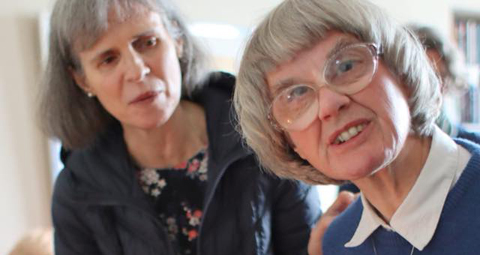June 28 | ![]() 0 COMMENTS
0 COMMENTS ![]() print
print

A life lived in devotion to Jesus
Mairi Clunas is a parishioner of St John’s Church, Portobello and one of the few ‘consecrated virgins’ in St Andrews & Edinburgh Archdiocese. Last month she celebrated the 30th anniversary of her consecration. In this article, she describes how she was drawn to this unusual but important vocation.
I was born on October 4 1957 in Inverness. Although my parents were not practising Christians I was Baptised in the Church of Scotland. I grew up with no sight in my left eye and only partial vision in my right. In this circumstance, however, can be seen the loving hand of divine providence for it was to lead me into the Church and open up the way to a relationship with God.
When the issue of my education arose, the authorities felt that I should attend the blind school. My mother, convinced that this was unnecessary, wanted me to receive a good all-round education: with this in view she approached the local convent.
The school for girls was run by the Daughters of Wisdom of St Marie Louis Grignon de Monfort; they were willing to accept me into the school even though I did not come from a Catholic family.
The director of education thought otherwise and, since there seemed to be no other solution, my mother decided to become a Catholic so that I could legitimately attend the school. This was a great gift to me for which I will always be grateful.
So it was that I entered a new and beautiful world: the realm of Faith. Every activity was permeated with a spirit of living Faith and prayer.
As I commenced school my physical health continued to give cause for grave concern and I would soon need major heart surgery. In view of the serious nature of the situation and the attendant risks surrounding such an operation, the Sisters felt I should be prepared for my First Holy Communion even though I was only five years old. This took place on the feast of Corpus Christi, 1963.
At the time I knew that a bride also wore a white dress and a veil and I had the ‘sense’ that I would not be clothed in this way again.
The following year, on Good Friday—the day on which the altars are stripped of their coverings—I was stretched out to be anaesthetised prior to the operation, which was to last seven or eight hours.
I was utterly terrified and with a loud cry yielded up my spirit. Afterwards I was ‘buried’ for several days in an oxygen tent while a nurse kept vigil by my bedside. This entire experience was truly a gift of Jesus’ love, with its close conformity to the pattern of his death. Even now, I can only approach this memory and the depths of its mystery in a spirit of humble, silent prayer.
I was Confirmed by Bishop Michael Foylan of Aberdeen on Pentecost Sunday, 1965: the previous day my mother and I had left the family home in a sudden dramatic flight, which was very distressing. School, however, continued to provide an atmosphere of nurture, stability and above all Faith.
I began to spend a little time each day in the chapel and gradually learned simply to rest in God. Essentially, this is still my prayer practice.
As I approached adolescence my mother entered into a new relationship with someone who had an existing family. Although life continued to be difficult, I discovered a deep interior life of prayer: Jesus was drawing me into a closer communion with his Mystery: to endeavour to live ‘through him, with him and in him.’
I began to attend daily Mass whenever possible and felt a real hunger for his presence. I also managed to buy a Jerusalem Bible and somewhat tentatively began to read the Gospels. This required perseverance but gradually it bore fruit in what would become the practice of Lectio Divina, which I still find very sustaining.
The prospect of leaving school was quite daunting since I was not really ready to forsake this supportive environment. I felt my path lay in the direction of religious life and I was greatly disappointed when this failed to come to pass. However, this was, in reality, an intervention of grace.
Feeling disorientated and after seeking some wise counsel I entered the University in Stirling to read languages. In the summer of my second year I suddenly had a detached retina in my right eye—the one with the sight! This meant another operation followed by a recovery process lying quite still in a semi-darkened room. I received Holy Communion most days and since I could not read and there were no other distractions I turned to prayer and made a silent retreat.
I soon discovered the writings of the Rhineland mystics and the Beguines, with which I felt a profound resonance. In this way I was first introduced to the concept of a more independent, less structured form of consecrated life, which was sustained by a deep personal relationship with Jesus.
As I approached the end of my course I met Mary, a Sister of the Sacred Heart, with whom I was to remain soul friends until her death in 2005 at the age of 94.
This was truly an intervention of grace: with great wisdom, gentleness and patience she helped to nurture my relationship with God; above all, however, she affirmed my sense of vocation.
Together we sought a way forward, taking into account all the circumstances, particularly the limitations imposed by my sight and less than robust health.
One of the many fruits of the Second Vatican Council was a revision of the Canon Law and along with it the restoration of the Rite of Consecration of Virgins which had long fallen into disuse.
Through Mary’s community in Aberdeen, we learned that there were two blood sisters living this vocation there, so we arranged to meet them. Although quite different in temperament they were both very prayerful and committed to the demands of a relationship with God, a visible witness of the reality of the vocation. After this, with Mary’s encouragement, I made a formal approach to the diocese enquiring about the possibility of receiving this consecration.
As this was unmapped territory, I was understandably met with great caution; however, I was not turned away and over a period of about 12 to 15 months I met regularly with the vicar for Religious in a process of discernment.
Finally, it was decided that the Consecration should take place. On the Feast of the Visitation, May 31, 1989, I made my public commitment to God in St Ninian’s with Archbishop Keith O’Brien.
At the time it was very stressful since I still faced opposition and misunderstanding at home, and in addition, the profession of vows is always a lonely and courageous undertaking.
Yet, there is also profound joy in responding to the Lord’s invitation; ultimately, it is only Jesus who makes this possible with the grace and gift of the Holy Spirit.
While it is always difficult to ‘evaluate’ a contemplative life, there are some features that characterise it. Above all there is the fidelity to silence and prayer, and attentiveness to the Word of God, which is lovingly pondered. It is also to cultivate a listening heart, open to the joys and sorrows of others which are then woven into the fabric of prayer.
It is important, too, not to overcrowd one’s life with too many people, events or things, so that the interior space becomes ‘cluttered.’
It is a trust in the permanence of God’s friendship. Sometimes this involves a search and at other times it is simply to rest one’s head on His Heart. For love is always His meaning.










